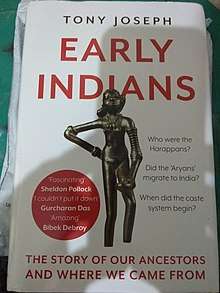Early Indians
Early Indians: The Story of Our Ancestors and Where We Came From is a 2018 non-fiction book written by Indian journalist Tony Joseph,[1][2][3] that focuses on the ancestors of people living today in South Asia.[4][5] Joseph goes 65,000 years into the past – when anatomically modern humans (Homo sapiens), first made their way from Africa into the Indian subcontinent.[6][7][8] The book relies on research findings from six major disciplines - history, archaeology, linguistics, population genetics, philology and epigraphy, and includes path-breaking ancient DNA research of recent years.[9] The book also relies on the extensive study titled "The Genomic Formation of Central and South Asia", co-authored by 92 scientists from around the world and co-directed by geneticist David Reich of Harvard Medical School, in which ancient DNA was used.[10][11][12]
 Cover of 1st edition | |
| Author | Tony Joseph |
|---|---|
| Country | India |
| Language | English |
| Subject | Human population genetics |
| Genre | Popular science Non-fiction |
| Publisher | Juggernaut Books |
Publication date | 20 December 2018 |
| Media type | Print (hardcover) |
| Pages | 256 |
| ISBN | 938622898X |
Description
The book discusses four prehistoric migrations in India.[13] The book posits that the Harappans were a mixture of Zagros agriculturists (from the modern-day Iran area) and First Indians,[14] a wave of migrants who came from Africa into Arabia and then reached India around 65,000 years ago.[15][16] Citing recent DNA evidence, the book traces the subsequent large migrations of anatomically modern humans into India—of agriculturalists from Iran between 7000 and 3000 BCE and Indo-European languages speaking pastoralists from the Central Asian Steppe (Aryans) between 2000 and 1000 BCE, among others.[17][18] Joseph uses the layers of a pizza as a metaphor to explain the make-up of subcontinental society.[19]
The book also discusses about similarities and differences between Indus Valley civilization and early Vedic civilization.[20][21] The book mentions that "Aryan" culture was most likely the result of interaction, adoption and adaptation among those who brought Indo-European languages to India and those who were already well-settled inhabitants of the region, and that Sanskrit and the Vedas developed in the Indian subcontinent.[22] Various tribes like the Andamanese and the Semang (Malay Peninsula), the Mani (Thailand) and the Aeta people (the Philippines) were the earliest inhabitants of Southeast Asia.[23] According to Joseph, Proto-Dravidian is related to the Elamitic language of Iran.[24] The caste system in India is a recent social system, reflected in sharply reduced inter-marriage (endogamy) and genetic mixing after 100 AD. This book also takes into account the path-breaking DNA research and findings from geneticist David Reich's research.[25]
Reception
The book was well received by readers and many critics.[26] Sujatha Byravan wrote in The Hindu that the book tells a compelling story of our forefathers based on genetic evidence.[27] Razib Khan of India Today said that the book presents a clear understanding of Early Indians.[28] Swaminathan Aiyar of The Times of India thought that the book helps us understand how all Indians have African, Harappan and Steppe Asian genes in different doses.[29] Author Gurcharan Das said that the book helps us understand that Indians are composed of a large number of small populations.[30] Kesavan Veluthat of The Hindu stated that the book shows a firm basis on which the study of Indian history can begin. This is of especial importance in the context of the post-truth conditions of the present, when myth-making seeks to replace authentic knowledge.[31]
Awards
- Best non-fiction books of the decade (2010-2019) - The Hindu[32]
- Book of the Year Award (non-fiction), Tata Literature Live, 2019 - The Wire[33]
- Shakti Bhatt First Book Prize 2019 - The Indian Express[34]
- Atta Galatta Award for best Non-Fiction, 2019 - Deccan Herald[35]
See also
References
- "A Question of Identity". 2019-02-09.
- "The first Indians".
- "New reports clearly confirm 'Arya' migration into India".
- "Can the arrival of the Aryans in India explain the disconnect between Harappan and Vedic culture?".
- "Where Do We Actually Come From? 'Early Indians' Author Explains".
- "'Early Indians' review: Who we are and where do we come from".
- "Excerpt: These Rocks in MP Reveal Secrets to Our Origin as Indians".
- "'We are a multisource civilisation, not unisource': Tony Joseph".
- "Early Indians on hindsight".
- "1 The Genomic Formation of South and Central Asia" (PDF).
- "How We, The Indians, Came to Be".
- "How Science Has Destroyed the Foundation of RSS' Idea of India".
- "Four prehistoric migrations shaped India's population".
- "How ancient DNA may rewrite prehistory in India".
- "The battle over the early Indians".
- "How the First Farmers Changed History".
- "Migrant Nation".
- "Horse sense on Harappa: An excerpt from Tony Joseph's book "Early Indians"".
- "We are like pizza. Early Indians were just the base: Tony Joseph".
- "How genetics is settling the Aryan migration debate".
- "Too early to settle the Aryan migration debate?".
- "Examining the evidence for 'Aryan' migrations into India: The story of our ancestors and where we came from".
- "Getting to know the Andamanese".
- "Who built the Indus Valley civilisation?".
- "From the Aryan migration to caste, two books offer fascinating insights into India's ancient past".
- ""Early Indians: The Story Of Our Ancestors And Where We Came From" by Tony Joseph".
- "'Early Indians' review: Who we are and where do we come from".
- "Review: The Indians Before India".
- "So much for Hindu Rashtra".
- "Who are we Indians? Genetics is bringing bad news for the politics of identity: We are all migrants".
- "Of India's genetic roots".
- "Best non-fiction books of the decade".
- "Writer Shanta Gokhale Honoured with Lifetime Achievement Award at Tata Literature Live".
- "Tony Joseph's Early Indians wins Shakti Bhatt First Book Prize 2019".
- "Four authors get Atta Galatta-BLF awards".